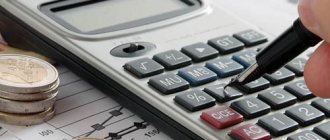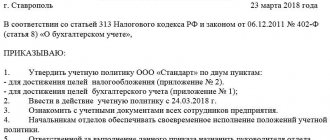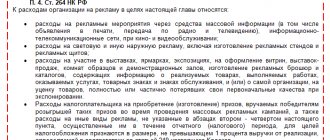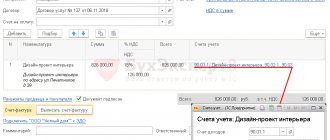Which depreciation group does a laptop belong to for tax accounting purposes?
A laptop is a type of fixed asset of an enterprise, regardless of the type of activity of the company, its scale, number of personnel and industry. A laptop should be depreciated because it belongs to the group of fixed assets of a company in the case when 2 conditions are simultaneously met:
- the laptop is used for the purpose of carrying out business activities of a company that generates income (this can be either the sale of goods, the provision of services or the performance of any work), or for management purposes;
- it costs at least 100 thousand rubles (see clause 1 of Article 257 of the Tax Code of the Russian Federation, clause 1 of Article 256 of the Tax Code of the Russian Federation).
The company's property subject to depreciation is depreciated for the purpose of calculating income tax - for this purpose, the objects are distributed depending on their useful life into various depreciation groups. To establish the useful life (it is determined at the time the fixed assets are put into operation) of a particular property, it is necessary to refer to the Classification of fixed assets (see Decree of the Government of the Russian Federation dated January 1, 2002 No. 1). The text of the Classification states that computers belong to depreciation group II, the objects of which are characterized by a useful life of 2 to 3 years inclusive.
Important!
The laptop should be classified in the OKOF group (All-Russian Classifier of Fixed Assets) “Computers and peripheral equipment” under code 330.26.2.
According to the Tax Classification, computers belong to the group “Other office machines”, which includes:
- data storage systems;
- network equipment of local computer networks;
- servers;
- printing devices for computers and so on.
Important!
Laptops are assigned depreciation group II. The useful life is from 2 to 3 years. The management of the organization has the right to independently establish an SPI for a laptop, but within the period specified in the Classifier - from 25 to 36 months.
Accounting for receipt of fixed assets
An enterprise has two classic options for organizing PC accounting.
Option No. 1. One object with the general name “Personal Computer”. This approach is welcomed by tax officials. The main argument of the inspectors: the components of a computer (monitor, system unit, keyboard and mouse) cannot be used by themselves, and, therefore, constitute a single accounting object (letter of the Ministry of Finance of the Russian Federation dated November 14, 2008 No. 03-11-04/2 /169). Often the total cost of components exceeds 40,000 rubles and therefore such a PC becomes a full-fledged part of the OS. This is easier to prove even if the inventory card lists all the components.
Although this option pleases tax authorities and is approved by the government, it has a number of inconveniences for an accountant:
- depreciation will have to be calculated;
- you need to prepare more documents (cards, commissioning certificates, write-off acts);
- in some cases it is difficult to correctly name an accounting object (for example, you cannot name a PC system when several monitors operate from one system unit);
- difficulties associated with writing off failed key elements or replacing them with more modern models.
The source of equipment receipt determines the correspondence of accounting accounts. PCs can be supplied to an enterprise from the following sources:
- as a contribution of participants to the authorized capital;
- for a fee under a sales contract;
- in exchange for other assets (similar and dissimilar);
- as a result of own production or construction;
- free of charge (as a gift or donation) ;
- as surpluses identified during inventory.
Having chosen this method of accounting for a PC, all costs associated with the acquisition of its individual components should be reflected in accounting using the following accounting entries:
1) The computer arrived at the enterprise: Dt 08 – Kt 60,71,76,98 ... (Kt depends on the source)
2) The VAT amount reflected is: Dt 19 – Kt 60, 71, 76.
Then, during commissioning, having drawn up an act of acceptance and transfer of an object for a laptop (form No. OS-1) or for a stationary multi-component computer an act of acceptance and transfer of groups of fixed assets (form No. OS-1b), they make the following entry:
3) PC was put into operation: Dt 01 – Kt 08 .
Option No. 2. All computer components are accounted for separately as independent objects. This option makes life much easier for an accountant who knows how to justify his position to regulatory authorities. Firstly, components accounted for separately will most likely cost less than 40,000 rubles, which means that in tax accounting they can be written off as material costs. Secondly, where there is no fixed asset, there is no need to calculate depreciation. Thirdly, if an object fails, it can be painlessly repaired or replaced, reflecting the cost of such work as a one-time cost.
Practical advice: to prepare for questions from tax authorities regarding the choice of this approach, stock up on arguments:
a) We can say that components are completely different inventory items because:
- traditional desktop PC components are not fully articulated objects (do not meet all requirements);
- can become spare parts for office equipment or can perform independent functions (for example, a hard drive can be used as a very large USB flash drive for storing information);
- can function in any other configuration different from the one received by the enterprise (for example, as a result of a breakdown, any device can be successfully connected to another computer).
And politely mention that you are familiar with court decisions in favor of such arguments (for example, the ruling of the Supreme Arbitration Court of the Russian Federation dated May 16, 2008 No. 6047/08)
b) Show the useful life of each PC component determined by the enterprise. They must differ significantly from each other, but comply with the regulatory boundaries for computer technology. The manufacturer's technical documentation can help with this. And then refer to clause 6 of PBU 6/01, which provides for such cases to maintain separate records for each component.
But remember: this option is easier to justify if the accompanying documents show the main components of the computer separately and have their own cost.
If the accountant begins to independently split the object “Lenovo H-50 Computer” into parts, this will raise many questions from the inspectors. Detailing in the documents will also help with modernization or partial liquidation.
By choosing this method, the accountant will have several objects. Some of them will become operating systems at a cost and should be taken into account in the same way as in method No. 1. And cheaper components will be capitalized as inventory. Both in accounting and tax accounting (when the owner of the computer is a profit tax payer), the entire cost must be written off at a time (clause 5 of PBU 6/01, clause 1 of Article 256 of the Tax Code of the Russian Federation). It might look like this:
- The monitor was received by the enterprise: Dt 10 – Kt 60,71,76,98 ... (depending on the source).
- The VAT amount reflected is: Dt 19 – Kt 60, 71, 76.
- The cost of the monitor was written off as expenses: Dt 20 – Kt 10.
Laptop depreciation in accounting - example of depreciation calculation
Since the straight-line accrual method is the most common in tax and accounting, let's consider an example of calculating depreciation in this way.
Let’s say a company purchased an expensive laptop worth 138 thousand rubles
.
The useful life was assumed to be 25 months
. Let's calculate the percentage of monthly depreciation deductions:
1 : 25 months x 100% = 4%
Every month, the company’s accounting will recognize the depreciation of the laptop in the amount of:
RUB 138,000 x 4% = 5,520 rubles.
Depreciation groups of fixed assets in 2021
So, in the OK 013-94 classifier the code is 142912131. Now this code should be designated in the OS Classification. After studying the document, you can see that pumps/compressor equipment with OKOF code 142912131 are classified as depreciation group No. 3 in 2020. This group includes property that has a useful life of more than three years, but less than five years (inclusive). For this reason, the accountant has the right to set any period within this interval for the purchased compressor. For example, Prazdnik LLC set a period of 4 years/48 months.
We recommend reading: Young Family Program in the Omsk Region 2020
To correctly establish the period, you need to know exactly which depreciation group this or that asset belongs to - this is where the asset classifier will help. This article will provide examples of how you can do this in 2021. switch to updated depreciation groups. The most convenient way to get acquainted with this is through examples: what happened in 2021. and what changes have occurred in 2021.
Common mistakes
Error:
A company whose core business is not information technology does not pay attention to the useful life of a laptop, taking into account its cost as part of material expenses.
A comment:
Only an organization that has passed state accreditation as a company operating in the field of information technology can take into account the cost of a laptop purchased by a company as part of material expenses.
Error:
The organization that purchased the laptop for the accounting department set the useful life to 1 year.
A comment:
Despite the fact that the All-Russian Classification of Fixed Assets does not contain instructions regarding SPI for laptops, a laptop belongs to computer technology along with computers. In this regard, it is advisable to set the useful life for the 2nd depreciation group - 2-3 years inclusive.
Computer = main tool? Not always
If we summarize the legislative calculations, then something is the main means if two conditions are met simultaneously:
- Useful life (expected) is more than 12 months.
- The original (historical) cost is more than 40,000 rubles. (by default; unless another limit is specified in the enterprise’s accounting policy).
The functional life of any PC is more than a year (the first condition is always met). But the cost of all types of computer equipment is different.
If you managed to purchase a computer cheaper than the limit value, then it should not be considered a fixed asset (OS). Such an object is considered as part of the inventory (clause 4 of PBU 5/01 and clause 5 of PBU 6/01).
If the computer was more expensive, then it is a legitimate fixed asset. And it will have to be amortized.
How to calculate the monthly depreciation rate using the linear method
Fixed assets are classified according to technical characteristics, making up groups, for example, buildings and structures, power machines and equipment, etc.
The existing classifier of fixed assets distinguishes 10 groups based on the duration of the operational time: the first groups include objects with a shorter useful time, the last - with a longer one.
What objects are depreciated? Legislators classify into the category of depreciable property objects whose life expectancy is more than 12 months, and whose acquisition cost exceeds 40 thousand rubles. Not all fixed assets can be considered depreciable.
Depreciation is not accrued on used leased fixed assets, land, environmental management facilities, road and forestry facilities, water resources or perennial plantings. Initial and residual value of fixed assets Let's return to the property objects for which it is necessary to charge depreciation.
IMPORTANT! Until recently, the chosen depreciation principle could not be changed to another throughout the entire period of deductions for this object. From January 1, 2014, an organization has the right to make a transition from a nonlinear to a linear method once every five years.
Important
For the reverse transition - from linear to nonlinear - there are no time restrictions; this can be done at any time, having previously made amendments to the regulations on the accounting policies of the enterprise.
- methods for calculating depreciation of fixed assets: How to calculate depreciation of fixed assets using the straight-line method To determine the amount of monthly depreciation charges using the straight-line method, you need to know the primary cost of the object, its operational life and calculate the depreciation rate.
1.
Calculating depreciation using the straight-line method: example
This indicator is established on the basis of the Classification of fixed assets included in depreciation groups, approved by Decree of the Government of the Russian Federation dated January 1, 2002 No. 1 (hereinafter referred to as the Classification of fixed assets).
An example of calculating depreciation using the straight-line method. depreciation of fixed assets
The basis for the calculation according to the linear principle is the following formula: the product of the original or replacement (if revaluation took place) cost and the depreciation rate established for this object, calculated as follows: N = 1/n * 100%, where n is the SPI in months or years. An example of calculating depreciation using the straight-line method. The Company purchased and put into operation an object worth RUB 180,000.
Attention
SPI for the OS group corresponding to the classifier – 5 years. Option 1: Let's calculate the annual depreciation rate: N = 100% / 5 years = 20%, i.e. 20% of the cost should be written off every year. In the amount of 180,000 * 20 / 100 = 36,000 rubles, i.e. over the year the price of the object decreases by 36 thousand rubles.
Monthly rate – 36,000 / 12 = 3,000 rubles. Option 2: monthly depreciation, calculation formula: H = 100%/60 months. = 1.6667 For the month, the amount of depreciation amounted to 180,000 * 1.6667 = 3000 rubles. This is how straight-line depreciation is calculated.
Calculation of depreciation using the linear method - an example Let us explain with a specific example how the linear method of depreciation is used in practice. On March 18, 2018, Gamma LLC purchased a woodworking machine for furniture production and registered it as a fixed asset at an initial cost of RUB 180,000.00.
The useful life of the machine was set at 72 months, since this fixed asset belongs to the 4th depreciation group according to the Classification of fixed assets.
Let's calculate the amount of depreciation charges for one month: Am = 180,000.00 x (1/72 × 100%) = 2,500.00 rubles.
Accountingstudy It is important to remember that depreciation is calculated only during the period of operation of the object, because only then does it wear out.
Prednalog.ru
By Artem Makarov / April 3rd, 2021 / Labor Law / No Comments After all, the amount of depreciation in this case directly depends on the size of the residual value of the fixed asset.
However: after the residual value of a fixed asset becomes equal to 20 percent of its original cost, the procedure for calculating depreciation must change.
Next month, this residual value is taken as the base amount and depreciation from it is calculated in equal shares (as with the straight-line method). This is stated in paragraph 5 of Article 259 of the Tax Code of the Russian Federation.
Example 4 In January 2002, Pride LLC purchased a computer worth 48,000 rubles. (including VAT - 8,000 rubles) and put it into operation in the same month. According to the accounting policy, the enterprise calculates depreciation of fixed assets for tax purposes using a non-linear method.
Pages: 20 21 22 23 24 25 26 27 28 AMBLYOPIA (from the Greek.
Linear method of calculating depreciation of fixed assets (example, formula)
Uniform attribution to expenses of the cost of depreciable fixed assets is the main convenience of the linear method. Calculation of depreciation using the linear method - an example Let us explain with a specific example how the linear method of depreciation is used in practice.
On March 18, 2018, Gamma LLC purchased a woodworking machine for furniture production and registered it as a fixed asset at an initial cost of RUB 180,000.00.
The useful life of the machine was set at 72 months, because This fixed asset belongs to the 4th depreciation group according to the Classification of fixed assets.
Let's calculate the amount of depreciation charges for one month: Am = 180,000.00 x (1/72 × 100%) = 2,500.00 rubles.
Computer useful life 2021
// Code OKOF (version until 01/01/2019) 14 3020000 - Electronic computing equipment, including personal computers and printing devices for them; servers of various performance; network equipment of local computer networks; data storage systems; modems for local networks; modems for backbone networks. Code OKOF (version from 01/01/2019) 330.28.23.23 - Other office machines (including personal computers and printing devices for them; servers of various capacities; network equipment for local area networks; data storage systems; modems for local area networks; modems for backbone networks) Let us recall that if the cost of a computer in accounting is no more than 40,000 rubles, it may not be recognized as an OS object at all and, accordingly, not be depreciated, but written off at a time as expenses as part of the inventory (clause 5 of PBU 6/01) . In tax accounting, objects no more expensive than 100,000 rubles must be accounted for as materials.
This is a duty, not a right of the organization (clause
Repair or modernization?
Sooner or later, a situation arises when it is necessary to either repair or improve existing equipment.
If components are purchased that are intended to replace computer equipment already in the organization, these are clearly inventories and do not need to be assigned inventory numbers.
The question then arises: “What is the difference between renovation and modernization?” (in terms of accounting). The difference is that modernization increases the cost of fixed assets that are subject to improvement, but repairs do not.
It is necessary to clearly define the nature of the expenses, since the residual value of fixed assets is subject to property tax of the organization, therefore, if you unreasonably classify repair as modernization and increase the cost of the computer, the cost of paying property tax will increase .
So, repair is the replacement of a failed component of a computer with one with similar characteristics (power supply, monitor with the same ones).
If components are accounted for as separate objects, then when replaced, those that have become unusable are written off. It will be necessary to draw up a Write-off Certificate. If parts of a computer that is on the balance sheet as a fixed asset are replaced, then the cost of the installed components is written off.
Costs are written off in the month they are incurred.
Example 3.
The computer's uninterruptible power supply, which is the main means, has burned out.
Modernization is the improvement of something. If, during computer repair, they replace, for example, the processor, hard drive, motherboard, etc. with more powerful ones, this will already be a modernization and it will be necessary to increase the cost of the computer as an inventory item.
Accounting for computer equipment during its modernization affects the 08 account, the costs incurred are collected on it. Upon completion of the work, the amounts from the 08 account are transferred to the debit of the 01 account to form a new initial cost
Requirements for depreciation groups
Control authorities devote maximum attention to checking the correctness of accounting, especially those conducted simultaneously with tax accounting. Therefore, it is important to know all the nuances and innovations in reflecting fixed assets in reporting documents. This will eliminate the risk of filling it out incorrectly and receiving fines.
Also read: How to draw up a loan agreement between individuals
The main feature of the classification of fixed assets in accounting and tax reporting is the service life. The law allows companies to independently classify their property into one or another depreciation group, based on the intensity of its use, the characteristics of economic and production processes and other factors that allow determining the period of useful service.
Complete computer: features of acquisition and acceptance for accounting (Mishanina M
For reference. The useful life of an object of fixed assets is the period during which it is intended to be used in the course of the institution’s activities for the purposes for which it was acquired, created and (or) received (for planned purposes) (clause 44 of Instruction No. 157n).
According to paragraph 34 of Instruction No. 157n, the acceptance of fixed assets for accounting is carried out on the basis of a decision of the permanent commission for the receipt and disposal of assets, drawn up with primary accounting documents approved by Order No. 173n, namely the act of acceptance and transfer of fixed assets (except for buildings, structures) (f. 0306001).
Also read: Application for a tax deduction for the purchase of an apartment to the tax office
Determining the useful life of the OS
Useful life is the number of years a company expects to use an asset. It is established based on:
- regulatory and other restrictions on the use of the facility.
- the expected life of the facility in accordance with its productivity or capacity;
- expected physical wear and tear, which depends on the operating mode (number of shifts), natural conditions and the influence of an aggressive environment, and the repair system;
In most cases, the “useful” life of fixed assets is established based on the Classification of fixed assets included in depreciation groups*. It can be used for both tax and accounting purposes.
According to this document, all fixed assets are divided into 10 groups with a useful life: - 1st - from 1 to 2 years inclusive; — 2nd — from 2 to 3 years inclusive; — 3rd — from 3 to 5 years inclusive; — 4th — from 5 to 7 years inclusive; — 5th — from 7 to 10 years inclusive; — 6th — from 10 to 15 years inclusive; — 7th — from 15 to 20 years inclusive; — 8th — from 20 to 25 years inclusive; — 9th — from 25 to 30 years inclusive; — 10th — over 30 years. Within these terms, the company can establish the useful life of certain fixed assets. Example: A company purchased a computer.
According to the Classification of fixed assets, it is included in the 2nd depreciation group (useful life from 2 to 3 years inclusive).
Based on this, the company determined that its useful life is 2 years. Exactly the same procedure is used to determine the useful life of an OS that has already been in use. It is installed according to general rules.
In this case, the time it worked for the previous owner can be taken into account. Example: A company purchased a used car. It is included in the 3rd depreciation group (useful life from 3 to 5 years inclusive).
Moreover, he worked for the previous owner for one year.
Accounting and example of calculating depreciation charges
Standard accounting entries for office equipment look like this:
- Dt 08 Kt 60 – the cost of office equipment and software settings for it is fixed.
- Dt 01 Kt 08 – equipment put into operation.
- Dt 20(26.44) Kt 02 – depreciation has been accrued (from the month following commissioning).
As noted above, in the vast majority of cases, for both NU and BU, it is advisable to use the linear method of calculating depreciation.
Optimal computer lifespan
In the current situation, branded computer help is widely available, but only a quarter of small companies have contracts to service their PCs. The rest prefer not to enter into them, contacting the relevant services as needed. The following figures indicate that such a policy is short-sighted. For a company in the area of medium and small business, the average cost of repair and maintenance of computer equipment ranges from $325 to $400. Interestingly, the cost of repairs is not a constant value; every year it grows by about one and a half times. Simple calculations allow us to find out that a computer that has been in use for five years will require a total expenditure of funds that may be enough to purchase two new machines.
How often to update your personal computer? This question faces not only individual users, but also companies from the small and medium-sized business segment. And if the average user often has to navigate according to personal income, then for companies and organizations such expenses are usually allocated as a separate item, which many try to reduce, especially in times of crisis. According to expert recommendations, the optimal period for updating a system unit is once every three years. This conclusion was made on the basis of research showing that the cost of computer repair and maintenance increases every year, and as a result, over time, it is more profitable to purchase a new one than to replace components in an old one. Although these studies were conducted by Techaisle analysts for Western companies, their results, with some amendments, can be easily transferred to domestic realities.
We recommend reading: Cost of Hot Water Supply in the City of Krasnoyarsk
Useful life of a computer
Contents How should a computer be taken into account in accounting and tax accounting: how should a single inventory item of fixed assets or its accessories be accounted for separately?
Depreciation group is a group of depreciable property objects (fixed assets and intangible assets), formed on the basis of useful lives. The main purpose of a depreciation group is to determine the useful life of an object.
According to clause 6 of the Accounting Regulations “Accounting for Fixed Assets” PBU 6/01, approved by Order of the Ministry of Finance of Russia dated March 30, 2001 N 26n, an inventory item of fixed assets is recognized as an object with all fixtures and accessories or a separate structurally isolated item intended to perform certain independent functions, or a separate complex of structurally articulated objects that constitute a single whole and are intended to perform a specific job.
In this case, a complex of structurally articulated objects is one or several objects of one or different purposes, having common devices and accessories, common control, mounted on the same foundation, as a result of which each object included in the complex can perform its functions only as part of the complex, and not on your own. Clause 1 of Art. 257 of the Tax Code of the Russian Federation establishes that fixed assets for profit tax purposes are understood as part of the property used as means of labor for the production and sale of goods (performing work, providing services) or for managing an organization. Taking into account the above, specialists from the tax authorities and the Ministry of Finance of Russia conclude that a computer is taken into account in accounting and tax accounting as a single inventory item of fixed assets.
They justify their point of view as follows: all computer accessories (monitor, system unit, keyboard and mouse) are a complex of structurally articulated objects, each of which cannot perform its functions separately (Letter of the Ministry of Taxes of Russia dated 05.08.2004 N 02-5-11/ [email protected] , Letter of the Ministry of Finance of Russia dated June 22, 2004 N 03-02-04/5).
In this regard, computer components (mouse, keyboard, monitor, etc.) purchased before assembling the computer
Useful life of a computer
→ → Current as of: August 4, 2021
We talked about which depreciation group a computer belongs to for the purpose of calculating the tax base for income tax. We will tell you in this material what useful life of a laptop or desktop computer should be established in accounting and how to calculate the depreciation rate of a computer.
Let us recall that in accounting, the useful life (SPI) of fixed assets (FPE) is established by the organization independently, taking into account the following factors ():
- regulatory and other restrictions on the use of the facility.
- expected physical wear and tear, which depends on the operating mode, natural conditions, the influence of an aggressive environment and the repair system;
- expected lifespan based on expected performance or capacity;
In practice, to reduce differences between accounting and tax accounting data, the useful life is established by analogy with tax accounting based on the Classification of fixed assets included in depreciation groups ().
After all, accounting legislation does not contain a ban on the use of such a Classification. And given that depreciation is calculated over the useful life, we can say that the depreciation period of a computer is over 2 years up to 3 years inclusive. Moreover, such a period can be set not only for computers, but also for other similar equipment.
This means that the same depreciation period for computer equipment can be set for printers, servers, network equipment, local area networks, etc. Let us recall that if the cost of a computer in accounting is no more than 40,000 rubles, it may not be recognized as an OS object at all and, accordingly, not be depreciated, but written off at a time as an expense as part of the inventory (). In tax accounting, objects no more expensive than 100,000 rubles must be accounted for as materials.
This is a duty, not a right of the organization ().
Computer depreciation period
Note! In order to correctly write off the cost of an object through wear and tear, it is necessary to receive the computer as a single object, and not in parts. In the latter case, the cost of individual components will be less, which will lead to accelerated write-off, the benefit of which is opposed by the Ministry of Finance of the Russian Federation (Letter No. 03-03-01-04/2/54 dated 04/01/05).
How computer depreciation is calculated in accounting and tax accounting depends on the cost of the object, as well as the adopted method for calculating depreciation. First of all, in order to determine the amount of depreciation, it is necessary to establish the useful life of the property. How to do this taking into account the current OKOF codes will be discussed further.
Computer shock-absorbing group
Depreciation groups for fixed assets from the beginning of 2021 are determined based on new rules regulated by the adopted Classification of fixed assets by depreciation groups and updated OKOF codes. In this regard, ordinary users have many questions regarding the determination of the depreciation group of a particular property.
Indeed, the innovations are quite significant: not only the configuration of the codes has changed (now they are written in the format ***.**.**.**.***.) but also the structure of the Classifier. With the introduction of new technologies, it takes into account objects that did not exist during the period of approval of the previous document, as well as some positions were deleted, combined or divided. For example, one generalized object “Information resources in electronic form” now includes several types of software. For some property items, changes to the OKOF code also resulted in changes in the useful life; for others, the changes affected only the code, without in any way affecting the period of effective use. Let's figure out which depreciation group the computer belongs to in accordance with the OS Classification adopted by Resolution No. 640 of 07/07/2020.
Standard computer service life
Any equipment has a certain service life, a computer is no exception. However, a PC is a set of specific components, each of which has its own service life. Let's figure out the average service life of a computer system unit and its components separately.
However, modern SSD drives do not have moving parts, so they have a longer service life. However, SSD hard drives do not last forever. There, memory cells have a certain resource and when recording/deleting information they become corrupted. However, with moderate use, such a disk will last for an average of 8 years.






